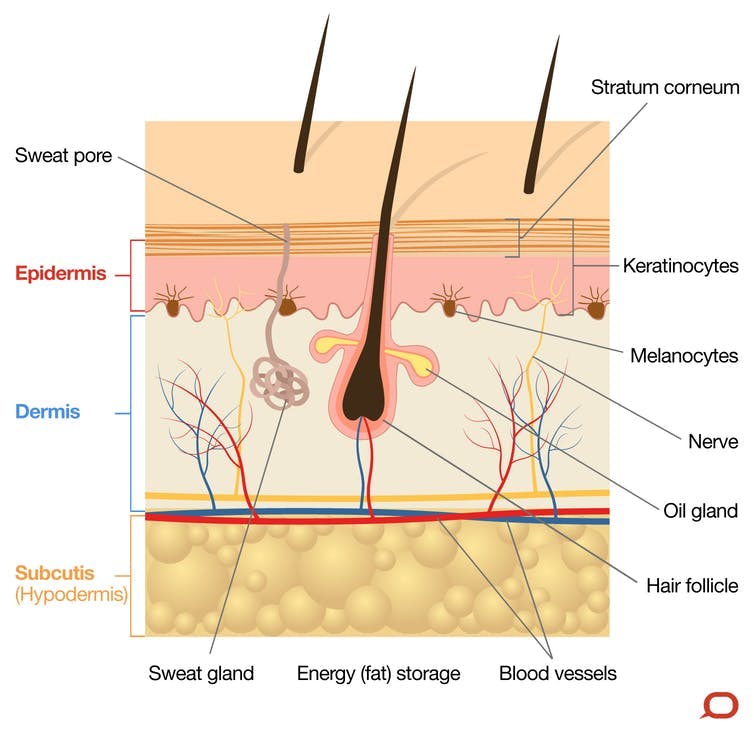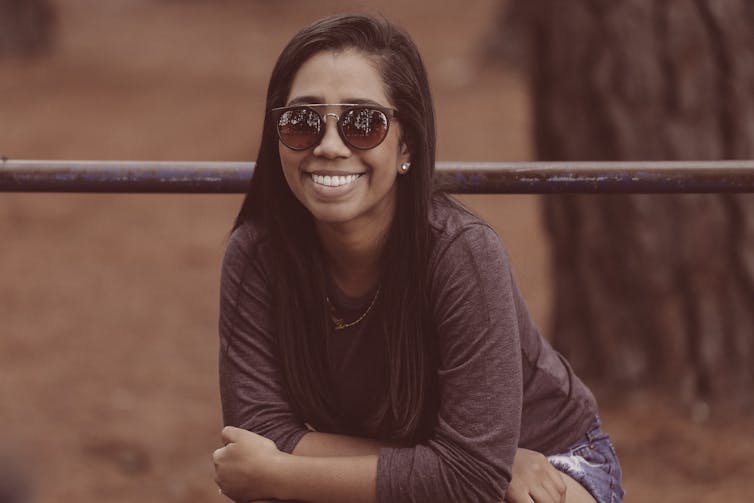what happens to our skin as we age?
- Written by Michelle Rodrigues, Consultant Dermatologist, St Vincent's Hospital Melbourne
This article is part of our series about skin: why we have it, what it does and what can go wrong. Read other articles in the series here.
The main factors that contribute to how old we look include the shape of our face, the number of lines or wrinkles, and the luminosity of our skin. Each of these is influenced by intrinsic and external factors.
Skin is the most visible organ. So ageing skin has a big impact on a person’s self-esteem. Aussies spend nearly A$5 billion per year on skin care products and treatments, with Queenslanders spending the most on beauty per capita.
Read more: The skin is a very important (and our largest) organ: what does it do?
Intrinsic ageing of the skin
Rates of intrinsic (also known as chronologic) ageing are predicted, to a degree, by our genetic makeup, including our skin colour.
With age, the epidermis (the top layer of the skin) becomes thinner and more transparent. This means that it reflects less light and so appears less luminous as time goes on.
The epidermis may also start to develop growths, including small brown dots (dermatosis papulosa nigra and seborrhoic keratoses) and overgrown oil glands, as well as spots that result from ultra-violet (UV) light exposure such as lentigines (freckles), melasma (pigmentation), solar keratoses (sun spots) and skin cancers.
Our dermis (the layer of skin under the epidermis) loses collagen and elastin as we age, causing the skin to sag and develop wrinkles when our muscles move under the skin. The blood vessels in the dermis also become thinner, which leads to easy bruising. And because the dermis and epidermis are thinner and hence closer together as we age, the blood vessels become more visible on the surface of the skin with time.
The reason collagen decreases as we age is complex, but is partly due to the reduced function of the cells that make collagen (fibroblasts) and an increase in the enzyme that breaks down collagen.
 Cross-section of the skin.
Cross-section of the skin.
Research has also shown that fat is lost and bone is resorbed from different compartments of the face at different rates, and this affects our perceived age.
When fat disappears from under the eyes (usually in our 20s or 30s), a dark shadow appears, making us look tired. And as the fat pad around the cheeks moves downwards (in our 30s and 40s), lines are created that extend outwards from the nose.
Read more: Why does Australia have so much skin cancer? (Hint: it's not because of an ozone hole)
Decreases in collagen and elastin cause frown lines and crows feet to develop, alongside other dynamic wrinkles (wrinkles from muscle movement). Meanwhile, the edge of the brow begins to drop and the lips start to thin out.
As we move into our 50s, collagen and elastin levels fall further, causing our wrinkles to deepen, and resorption of bone occurs around the eyes causing “bags” to form. Fat hanging from now less-elastic skin causes our eyebrows and nasal tips to droop and the skin on our neck to sag.
But intrinsic factors aren’t the whole story. Our lifestyle, environment and habits also play a role in skin ageing.
Extrinsic ageing of the skin
Extrinsic ageing can be induced by environmental factors such as UV exposure, smoking and air pollution. This means the skin’s apparent age and its chronological age are not always the same.
UV light breaks down elastin in the dermis, causing saggy, stretchy skin. The skin also bruises and tears more easily and takes longer to heal with ongoing exposure to UV rays.
Tobacco smoke results in insufficient oxygen supply to the skin and blocked blood vessels. It reduces immunity (meaning skin cancers can develop more easily) and increases the level of an enzyme that breaks down collagen. Reduced collagen results in wrinkles and loss of volume. Smoking also increases dryness, coarseness and a dull appearance of the skin, and increases wrinkles around the mouth.
Recent research also suggests a positive correlation between air pollution and extrinsic skin ageing, with 20% more pigment spots noted on the forehead and cheeks of those with exposure to more soot and particles from traffic.
 More pigmented skin is usually thicker, meaning it won’t wrinkle as much as white skin.
tikkho maciel unsplash
More pigmented skin is usually thicker, meaning it won’t wrinkle as much as white skin.
tikkho maciel unsplash
Differences in ageing
So why is it that people of different ethnicities and skin colours seem to age differently? Different types of skin have different amounts of elastin, collagen, pigment cells (melanocytes), and fats.
Darker skin has larger, more numerous melanosomes, which manufacture, store and transport melanin, in turn giving the skin pigment. This provides protection against UV rays in people with darker skin types.
The average protective factor against UV-B radiation in black skin was found to be 13.4 – compared with 3.4 for white skin, while the average rate of UV-B transmission into the dermis was 5.7% in black skin, compared with 29.4% in white skin.
Read more: Common skin rashes and what to do about them
While increased melanin serves as an inbuilt sunscreen, it’s also the responses of these pigment cells that make patients with skin of colour more susceptible to pigment problems over time.
And those with darker skin types are said to have a thickened outer layer of the skin with larger and more numerous fibroblasts (cells that make connective tissue and collagen) and compact collagen. This means this type of skin won’t wrinkle as easily, but has a greater chance of keloid scarring (overgrowth of scar tissue).
So it seems that not all skin is created equal, but there are things we can do to optimise our skin health. Sun protection (hat, sunscreen, seeking shade) and avoiding smoking are good places to start. Retinoids have been proven to help minimise fine lines, pigmentation and to increase collagen and repair sun-damaged skin.
As for the myriad lotions and potions that claim to magically make us look 21 again … if I find one that works I’ll let you know.
Read more: Four of the most life-threatening skin conditions and what you should know about them
Authors: Michelle Rodrigues, Consultant Dermatologist, St Vincent's Hospital Melbourne
Read more http://theconversation.com/wrinkles-liver-spots-crows-feet-what-happens-to-our-skin-as-we-age-91516





